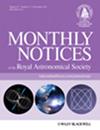真正的独角兽和假阳性:明亮恒星暗质量伴星的模拟概率
IF 4.8
3区 物理与天体物理
Q1 ASTRONOMY & ASTROPHYSICS
引用次数: 0
摘要
许多致密天体(黑洞和中子星)以双星形式存在。这些双星通常是通过它们之间的相互作用被发现的,或者是作为 X 射线双星的吸积,或者是作为引力波源的碰撞。然而,双星中的大多数紧凑天体应该是不相互作用的。最近提出的发现使用了一颗明亮恒星(主序星或演化星)的径向速度,这颗恒星表明有一颗大质量但暗色的伴星,而伴星被推断为紧凑天体。不幸的是,这个新兴领域一直受到假阳性天体的阻碍,包括 "独角兽"(V723 Mon),它最初被认为是一个红巨星/黑洞双星,后来被驳斥。在这项工作中,我们利用双星演化代码 COSMIC 来模拟双星群,并确定候选天体是 "真正的独角兽"(双星中实际的紧凑天体)还是假阳性天体的概率,从而研究恒星双星群随时间的演化。我们发现,主序星的 "真独角兽 "概率要高于红巨星或裸氦星(已演化恒星的外露内核),尤其是当伴星的质量更大、亮度比主序星低≥3 倍时。我们还发现,头重脚轻的初始质量函数会进一步提高真正独角兽的概率,超太阳金属性会降低概率,而且大多数真正独角兽的周期≤100 天。最后,我们发现在宇宙年龄期间,有相当一部分真正的独角兽并没有演化成X射线双星。本文章由计算机程序翻译,如有差异,请以英文原文为准。
True unicorns and false positives: Simulated probabilities of dark massive companions to bright stars
Many compact objects (black holes and neutron stars) exist in binaries. These binaries are normally discovered through their interactions, either from accretion as an X-ray binary or collisions as a gravitational wave source. However, the majority of compact objects in binaries should be non-interacting. Recently proposed discoveries have used radial velocities of a bright star (main sequence or evolved) that are indicative of a massive but dark companion, which is inferred to be a compact object. Unfortunately, this burgeoning new field has been hindered by false positives, including the “Unicorn” (V723 Mon) which was initially believed to be a red giant/black hole binary before being refuted. In this work, we investigate the evolution of stellar binary populations over time, using the binary evolution code COSMIC to simulate binary populations and determine the probability of a candidate object being either a “true Unicorn” (actual compact objects in binaries) or a false positive. We find that main sequence stars have a higher true Unicorn probability than red giants or naked helium stars (an exposed core of an evolved star), particularly if the companion is more massive and is ≥3 times less luminous than the MS star. We also find that a top-heavy initial mass function raises the true Unicorn probability further, that super-solar metallicity reduces the probability, and that most true Unicorns are found at periods ≤100 days. Finally, we find that a significant fraction of true Unicorns do not evolve into x-ray binaries during the age of the universe.
求助全文
通过发布文献求助,成功后即可免费获取论文全文。
去求助
来源期刊

Monthly Notices of the Royal Astronomical Society
ASTRONOMY & ASTROPHYSICS-
CiteScore
9.10
自引率
37.50%
发文量
3198
审稿时长
3 months
期刊介绍:
Monthly Notices of the Royal Astronomical Society is one of the world''s leading primary research journals in astronomy and astrophysics, as well as one of the longest established. It publishes the results of original research in positional and dynamical astronomy, astrophysics, radio astronomy, cosmology, space research and the design of astronomical instruments.
 求助内容:
求助内容: 应助结果提醒方式:
应助结果提醒方式:


